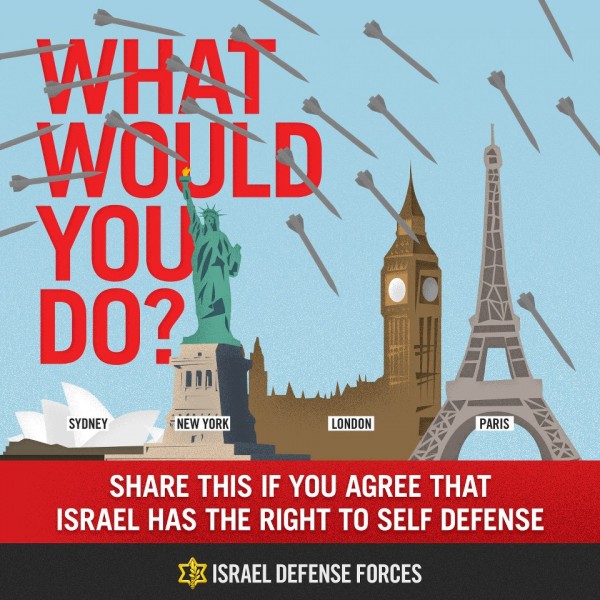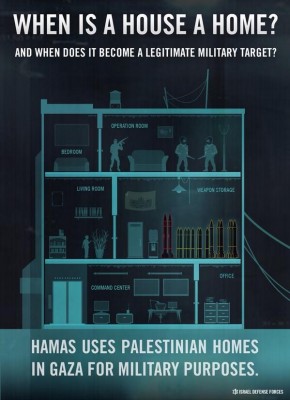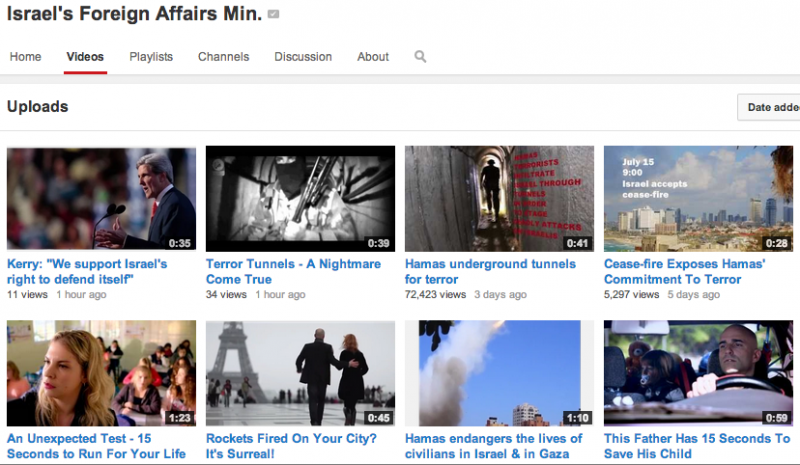Written and translated by Leila Nachawati. A version of this article appeared on the website of Spanish daily Eldiario.es, in Spanish.
Israel’s attacks on Gaza in 2009 were the first case of a conflict mediated by social media. Both inside and outside the Gaza strip, citizens and members of Hamas used Facebook, Twitter, YouTube and other platforms to narrate, document and condemn the attacks. But no group’s use of these platforms was as intensive and coordinated as that of the Israeli Defense Forces (IDF).
Five years later, while scenes of death and devastation repeat themselves in Gaza, Israel has redoubled its online propaganda in an attempt to show the world its kinder side.
An online struggle for “hearts and minds”
Israeli military operations are always accompanied by robust media reports that seem intended to mitigate their impact on international public opinion. From the sensorial “Cast Lead” in 2009 to the self-explanatory “Protective Edge” in 2014, several fronts of “hasbara” (pro-Israeli propaganda, in Hebrew) have been developed to show the world Israel’s rationale.
In 2008, just before attacks on Gaza began, the Israeli administration decided to replace traditional press conferences of war time with a wide array of initiatives based on social media. Guidelines for the campaign were developed by former army officer Yarden Vatikai, in coordination with the Ministry of Defense and the Jewish Agency.
One of the initiatives consisted of teaching new media workshops to army officers in the Herzliya Interdisciplinary Center.
“In terms of communicating our message, the future is in new media”, Defense Forces spokesman Avi Benayahu said in February 2009. “The IDF has moved online to win hearts and minds.”
YouTube served as the main front for the campaign, rendering Israel’s the first national army to establish its own YouTube channel. The channel includes a videoblog where army spokespersons describe the attacks as “humanitarian self-defense actions.”
The 2009 ‘hasbara’ efforts included direct contact with journalists from all over the world. SMS messages were sent on a daily basis to thousands of journalists, diplomats and influential bloggers, with press notes, informative sessions and visits to the Israeli communities of the Negev, on the border with Gaza.
Israeli social media strategist expert Niv Calderon was hired by the Ministry of Foreign Affairs prior to the invasion of Gaza. His mission was to create “an unprecedented war room to promote Israeli propaganda internationally.” In the words of Calderon, “There is a media war, and each citizen, each computer user, is a soldier.”
Haneen Zoubi, Director of I’lam Media Center for Arabs and Palestinians in Israel referred to coverage of the 2009 attacks as “a mockery of press freedom.”
In 2006, during the invasion of Lebanon, she denounced the Israeli press, saying they had “abandoned their journalistic role, without announcement or apology. (…) It seems that they are no longer capable of performing their professional duty as they have all become subservient to “patriotism”.
International Press Director for the IDF Avital Leibovich, on the other hand, claimed to be “positively surprised” by international coverage of the conflict, even in media considered to be neutral or not pro-Israel. “Finally, the international community understands that Hamas is the aggressor,” she said.
Hasbara efforts expand
Five years later, the involvement of the army in the documentation and dissemination of propaganda has increased, through YouTube videos and official accounts on Facebook and Twitter, which show a constant flow of messages.
Today’s media strategy includes dozens of infographics and visualizations that attempt to depict Israel’s rationale in a graphic and simple manner similar to that employed by the award-winning Visualizing Palestine project, which focused on visualizing the effects of occupation for Palestinians in Gaza.
One of the most viral visualizations shows how a house in Gaza becomes a target. “When is a house a home and when does it become a military target?”, the image reads, in response to accusations that Israel indiscriminately bombs houses in Gaza. Another one compares “what Israel does to protect civilians” vs. “what Hamas does to endanger its civilians.”
Another powerful visualization (see above) shows rockets falling over several world capitals, including New York, London and Paris.
The eye-catching graphic urges Internet users to share the image if they “think Israel has the right to self-defense”.
The 2014 “hasbara” campaign also includes video ads that pop up while a user is watching a YouTube video. The account is managed by Israel’s Foreign Affairs Ministry and contains several anti-Hamas propaganda videos.
Between 2009 and 2014, efforts expanded to include larger segments of Israeli society in online battles, with a strong focus on universities. According to an article published by Haaretz in August 2013, The Prime Minister's Office was planning to form, in collaboration with the National Union of Israeli Students, “covert units” within Israel's seven universities to engage in online public diplomacy (hasbara).
In 2014, the University of Haifa announced a cyberwar course to fight the delegitimization of Israel online. Other universities coordinating propaganda initiatives are Bar-Ilan, the Hebrew University and Ben Gurion University.
The story told by Israel's official propaganda machine clashes with the images of devastation in Gaza. On July 16 alone, four children were killed by Israeli warplanes as they played on the beach, and Gaza’s Wafa hospital was shelled to pieces by Israeli tanks. So far, 77 percent of the victims are civilians, a dribble that Israeli historian Ilan Pappé has referred to as an “incremental genocide”.
The military's media campaign also pushes a narrative that some Israelis firmly reject. Citizen-led online initiatives such as Breaking the Silence and B'Tselem, along with public protests, articulate a story very different from the official line.











3 comments
Support humanity. Support palestiians right.
Well they’re getting desperate. There’s no flag large enough to hide the murder of over a 100 children.